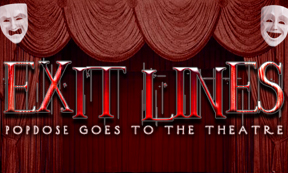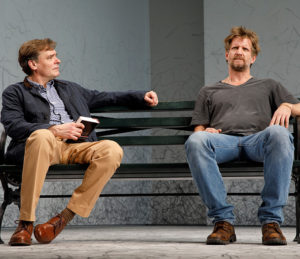 In the last couple of weeks I’ve spent so much time at the Signature Theatre I’m getting my mail delivered there. Here’s what’s on at the Frank Gehry-designed gem at the end of 42nd Street.
In the last couple of weeks I’ve spent so much time at the Signature Theatre I’m getting my mail delivered there. Here’s what’s on at the Frank Gehry-designed gem at the end of 42nd Street.
The New Group has two productions going. After its successful revival of David Rabe’s savage Sticks and Bones in 2014, the company is staging the New York premiere of his latest play, Good for Otto. While it has a few trenchant things to say about the sad state of our health care system (the setting is a mental health clinic in rural Connecticut) it takes Rabe a long-winded three hours to say them, with too much of those given over to whimsical asides, like the entire large cast (pictured above) indulging in quaint little singalongs. (Otto is a pet hamster, which should tell you something about the play’s woozy tone.)
Some of the play takes place in the imaginings of its protagonist, Dr. Michaels (Ed Harris), who himself can’t get over the mother issues that emotionally hamstring a few of the facility’s patients, notably Otto’s autistic owner, Timothy (a sentimental child-man turn for Mark Linn-Baker), and a pre-teen cutter, Frannie (Rileigh McDonald, a former Matilda), whose latest foster parent, Nora (Rhea Perlman), is at her wit’s end. Michaels’ colleague, Evangeline (Amy Madigan), is also struggling with a contingent of no-hopers, including Barnard (F. Murray Abraham), who at 77 is pondering mortality. Abraham’s monologues, as dexterously delivered as you might expect from a wily veteran (one’s performed as he changes from pajamas) offer respites from the surrounding murk. Otherwise the boldface names are awkwardly cast: Harris and Madigan, New Group mainstays, seem too old for their parts, and Perlman is more grandparent than mother. They at least have a fighting chance with their material–as the clinic administrator, Lily Gladstone, the Native American actress who received considerable acclaim for the indie film Certain Women, runs on and off stage barking orders, and does not.
Introducing a tormented gay character into the mix just when you’re wondering why there isn’t a tormented gay character in the mix, Good for Otto is like several seasons of HBO’s In Treatment jumbled together. Michaels’ rancorous phone conversations with a case manager (Nancy Giles) at “Colossal Care Insurance” have a bit of contemporary life to them, unlike the stale dramaturgy underpinning his past (his mother, who killed herself, stops by for insinuating visits) and those of the patients. Director Scott Elliott hasn’t given us much to look at besides the chairs the overemoting players sink into (New Group productions usually have more visual snap to them) and when the first act concluded with Abraham announcing “To be continued” the woman behind me snapped “Not for me! The end!” and stormed out of the theater. With Good for Otto, Rabe, who was inspired by a book titled Undoing Depression, inadvertently triggers it.
 “Dip me in chocolate/Throw me to the lesbians.” Eat your heart out, Stephen Sondheim–Jerry Springer: The Opera has finally hit town, after 15 years of exasperating sensitive viewers since its Olivier-winning showcase in London. My wife and I saw its North American premiere, in Chicago, in 2007, and before this its only New York exposure was a Carnegie Hall staging ten years ago, starring Harvey Keitel, of all people, as Jerry. David Soul, a West End regular at the time, created the part, which was played by Broadway stalwart Terrence Mann (Cats, Les Miz) when I saw it. Matt McGrath, a more “Jerry-ish” type than the urbane Mann, is closing out the run, which differs from preceding productions in that Springer, who goes to hell and back (literally) in the course of the show, now sings a couple of songs. (Why shameless Jerry himself hasn’t played the role of his lifetime is a mystery.)
“Dip me in chocolate/Throw me to the lesbians.” Eat your heart out, Stephen Sondheim–Jerry Springer: The Opera has finally hit town, after 15 years of exasperating sensitive viewers since its Olivier-winning showcase in London. My wife and I saw its North American premiere, in Chicago, in 2007, and before this its only New York exposure was a Carnegie Hall staging ten years ago, starring Harvey Keitel, of all people, as Jerry. David Soul, a West End regular at the time, created the part, which was played by Broadway stalwart Terrence Mann (Cats, Les Miz) when I saw it. Matt McGrath, a more “Jerry-ish” type than the urbane Mann, is closing out the run, which differs from preceding productions in that Springer, who goes to hell and back (literally) in the course of the show, now sings a couple of songs. (Why shameless Jerry himself hasn’t played the role of his lifetime is a mystery.)
The show’s first act, a recreation of a typical episode concocted by Richard Thomas (not that one) and Stewart Lee, is an absolute riot, a bacchanal, a high-style assault on good taste. Dripping with piety, the ringmaster trots out the hour’s freaks: the trailer-trash adulterers, poopy-pants diaper fetishists, and “chicks with dicks,” all of whom have their vulgarly operatic say. Though mourning the scandalous end of his career in Democratic politics, Jerry prides himself on providing some sort of forum for those on society’s lowest rungs, who throw themselves at the camera, and each other, hoping for stardust to rub off. But he’s irked by his new warm-up man (Will Swenson), who’s goosing the crowd too hard.
When one nutcase “takes his shot,” as the star of a more decorous musical might say, Jerry, hovering in purgatory, discovers that warm-up man is actually Satan, who wants him to referee a grudge match with God. It’s the debauched lowlifes from Act One returning as Biblical characters in the second act that’s inflamed some audiences (most spectacularly, Justin Keyes’ transsexual Montel morphs into Jesus) but here in jaded, soul-dead New York that’s kind of a yawn (mock TV commercials promoting guns got more of a rise), and as in Chicago the show droops into a faux-religious muddle. (The Book of Mormon may have learned from its strengths and weaknesses.) Director John Rando (Urinetown) provides the “visual snap” in spades on the Signature’s most intimate stage, to little avail. Swenson, no musicals slouch himself, lets loose a mighty, multisyllabic “fuck” at one point, trilling the word for what felt like a full minute, but to hell with God, I wanted my freaks back, like diapered siren Baby Jane (Jill Paice). Final thought: While Jerry Springer: The Opera is a divine inferno at its zenith, the White House show has far outstripped it in moral and ethical retardation.
 Edward Albee’s At Home at the Zoo conjoins his first Off Broadway success, the one-hour The Zoo Story (1959), with its late career prequel, Homelife (2004). Mounted at New York’s Second Stage as Peter and Jerry in 2007, the show has returned under its new and deadly accurate title: The home may be near cozy, prosperous Central Park, but wild things abound.
Edward Albee’s At Home at the Zoo conjoins his first Off Broadway success, the one-hour The Zoo Story (1959), with its late career prequel, Homelife (2004). Mounted at New York’s Second Stage as Peter and Jerry in 2007, the show has returned under its new and deadly accurate title: The home may be near cozy, prosperous Central Park, but wild things abound.
Then and now, my feeling is that Homelife is unnecessary, restating what’s obvious in The Zoo Story, but Albee (who died two years ago) decreed that they be performed together. In collaboration with director Lila Neugebauer and Andrew Lieberman (who has scribbled together a wonderfully abstracted set in the Signature’s largest venue), Robert Sean Leonard, as textbook publisher Peter, and Katie Finneran as his loving wife Ann, do what they can with tryingly “provocative” material. Peter’s complacency is disrupted when Ann, who keeps her discontent hidden, reveals elaborate sex fantasies and goes otherwise TMI on their marriage. Order is restored as quickly as chaos descended, and Peter goes out for a walk.
In The Zoo Story, Peter is all but ambushed by Jerry (Paul Sparks), a talkative bohemian he meets in Central Park. Jerry’s chatter, however, goes from insinuating to insane, and a primal battle erupts on the park bench. All id, Sparks (he was the disapproving critic in The Greatest Showman, and is quite the showman himself in this kind of let-it-all-hang-out role) pulls out every stop as Jerry, as does Finneran, who brings an explosive candor to Ann. (That’s not to overlook Leonard. Good as they are, this exceptional stage actor has the chops to make Peter’s composure compellingm, and gives them something to ricochet off.) If Homelife is Albee “doing” Albee, laboring to shock, The Zoo Story is Albee in undiluted form, pouncing onto the scene, unleashed–and reason enough to recommend the pairing.





Comments